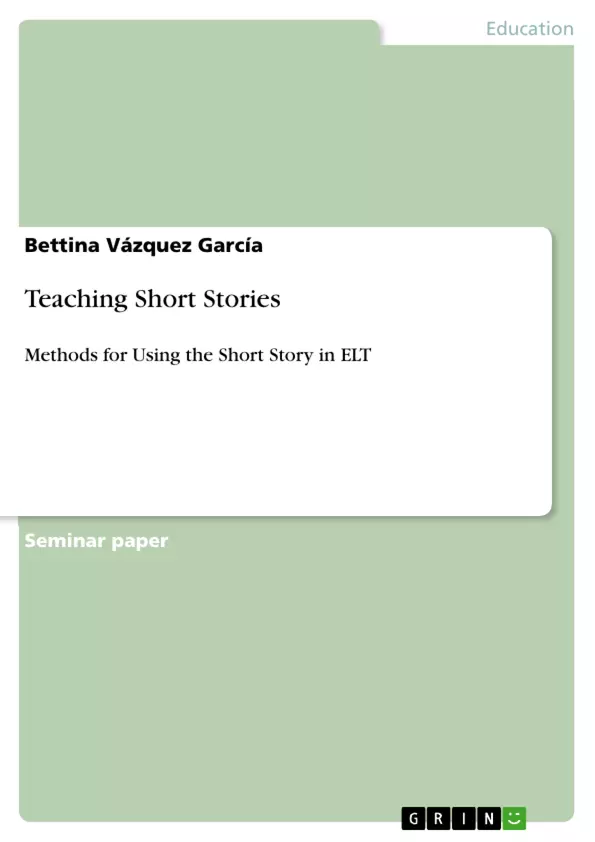The use of literature in the second language classroom can be legitimated in different ways. Todays methods of second language acquisition (SLA) put emphasis on working with literature which offers a great range of opportunities to familiarize a learner with a foreign language. However, it is not just the aspect of learning or acquiring a second language when dealing with literature. Furthermore, the work with literature includes social and cultural as well as empathetic aspects. Thus, dealing with literature, whatever genre of literature is touched, is highly manifold and undoubtedly of a high value. According to Wolfgang Gehring, the short story, besides the novel, is one of the genres which is used most frequently in school. The short story has many uses concerning the field of didactics: it can be used for introducing different topics and for accustoming the learner to different methods of interpretation. In addition, working with literary texts, especially with short stories, offers the possibility for the examination of several problems, e.g. problems of youths or the topic of life and death. In the framework of the term paper at hand, the focus lies on working with literary texts, namely teaching short stories as one component of the narrative genre besides the novel. For this purpose there will first be a short discussion about the significance of literary texts in language teaching according to Ansgar Nünning, who claims that literature forms an essential part when learning a foreign language (FL). In addition to that, the emphasis in the following chapters lies on working-techniques for dealing effectively with short stories in language teaching. For this purpose different methods for the work with short stories are presented and critically examined. The presented methods are divided into pre-, while-, and post-reading activities. However, in spite of the presentation and explanation of several strategies of teaching short stories one has to bare in mind that a universal formula of how to deal with literature does not exist. Eventually the teacher has to find the method which he favours and his pupils might favour as well and which he considers having the greatest learning effect.
Inhaltsverzeichnis (Table of Contents)
- Introduction
- The significance of literary texts in language teaching
- Characteristics of the short story
- Why should short stories be used in ELT?
- Teaching short stories: methods and approaches to teach short stories
- Pre-reading activities
- While-reading activities
- Post-reading activities
- Conclusion
- Bibliography
Zielsetzung und Themenschwerpunkte (Objectives and Key Themes)
This paper examines the significance of literary texts, particularly short stories, in English Language Teaching (ELT). It aims to explore the pedagogical value of short stories as a resource for language acquisition, cultural understanding, and development of reading and writing skills. The paper focuses on various methods and approaches to teach short stories, highlighting pre-, while-, and post-reading activities that enhance comprehension and promote engagement with the text.
- The pedagogical benefits of using literary texts in language teaching
- The characteristics and advantages of short stories in ELT
- Different methods and strategies for teaching short stories in the classroom
- The importance of pre-, while-, and post-reading activities in short story instruction
- The need for finding appropriate methods for teaching short stories based on individual student needs and learning styles
Zusammenfassung der Kapitel (Chapter Summaries)
The introduction emphasizes the importance of literature in second language acquisition and highlights the diverse benefits of using short stories in ELT. It also provides an overview of the paper's structure and objectives.
The second chapter discusses the significance of literary texts in language teaching, focusing on the unique advantages of short stories. It explores the characteristics of the short story, its suitability for various levels of language learners, and its ability to enhance vocabulary, reading comprehension, and cultural understanding.
The third chapter delves into different methods and approaches for teaching short stories. It explores pre-reading activities that prepare students for the text, while-reading activities that promote active engagement with the content, and post-reading activities that facilitate critical thinking and analysis.
Schlüsselwörter (Keywords)
This paper focuses on the use of short stories in English Language Teaching (ELT). It explores the benefits of literary texts, specifically short stories, for language acquisition, cultural understanding, and the development of reading and writing skills. It also examines different methods and strategies for teaching short stories, highlighting the importance of pre-, while-, and post-reading activities in promoting comprehension and engagement with the text.
- Citation du texte
- Bettina Vázquez García (Auteur), 2007, Teaching Short Stories, Munich, GRIN Verlag, https://www.grin.com/document/143940



